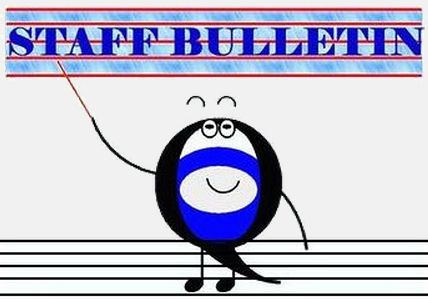You probably thought that I was calling a Quest Teaching Staff Meeting. No, that isn’t it. The Staff that I am referring to is the – Music Staff.
If you look closely, you will see red lines behind the words “Staff Bulletin” in my picture. How many red lines did you count?
Please focus your attention on the 5 lines behind, Staff Bulletin.
These 5 horizontal lines and the 4 spaces in between them, join together to form the Music Staff on which music is written.
You can envision the music staff as the primary grid or map where the notes will be placed. High notes will be towards the north (up) and low notes will be towards the south (down).
Scroll has returned to share a tale about the origins of the staff!

Rhythm Laboratory Notation Parts Note Heads Stems Beams Flags Note Construction
Common-Time Measures Bar-Lines Counting in Common-Time Whole, Half and Quarter Notes
Ties Dots Time-Signatures Q’s Rhythm Review Time-Signature Rules Beat Accent
Down-Beat and Up-Beat Conducting Patterns Cut-Time Common-Time Beat Emphasis
Three-Beat Measures Note Values Rhythm Workouts The ‘Cycle’ Note Equivalents
Counting Sub-Divisions “If You Can Say It, You Can Play It” Author’s Story Sub-Division Lingo
Quarter Notes with Eight Notes Adding Sixteenth Notes Notes Sharing Beams Beam Awareness Pointers
Triplets Triplet Workout Compound-Time Compound-Time Workout Music Rests
Rest and Note Equivalents Whole Rest Half Rest Quarter Rest Eighth Rest Sixteenth Rest
Dotted Rests Q’s Rest Review Process of Sub-Division Relating Rests to Notes Rhythm Exam Prep
Level 1 Rhythm Exam Level 2 Rhythm Exam Level 3 Rhythm Exam





